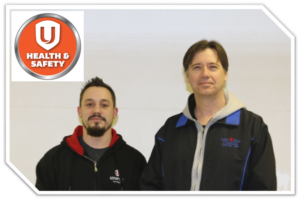Health and Safety Report Jan 2021
The New Metal Removal Fluid Medical Surveillance Program
For the past four years, we have been working very hard to help improve the air quality of our workplace. Many workers over many years have expressed concerns related to their health and safety from working in a machining environment that uses coolants or metal removal fluids.
Metal Removal Fluids (MRF) are defined as a broad category of fluids used in machining operations that are comprised of various petroleum oils or non-petroleum-based chemicals that may be mixed with water, used to cool the tool-workpiece interface, reduce friction and flush away metal chips and fines. In most of our machining processes, a continuous stream of MRF is supplied to the cutting edge of the machine tool where motion of the spindle generates heat, vapour, mist and splashing. Maintenance of MRF and Oil Mist Collection (OMC) systems are critically important as we are exposed to these chemicals through skin contact and inhalation of the air we breathe while we work. The GM definition of Occupational Exposure Limit is the level below which it has been determined nearly all workers may be repeatedly exposed to a chemical day after day without adverse health effects. Unifor and GM have agreed to exposure limits for MRF, and our plant is well within and below these limits. Our Plant Leadership has worked well with us over the past four years on many initiatives to help lower exposure levels, including the establishment of an Air Quality Committee where we jointly work to make recommendations for resolving issues. However, the Ontario Health Clinics for Ontario Workers (OHCOW) have provided us with recent studies that show people may experience symptoms at the exposure levels we have at STCPP.
MRFs are associated with potential health risks of dermatological (skin) disorders and lung disease when inhaled or when skin contact occurs. Skin disorders include folliculitis, oil acne, keratosis, and irritant or allergic contact dermatitis; Lung diseases include lipid pneumonia, hypersensitivity pneumonitis, occupational asthma, acute airways irritation, chronic bronchitis and impaired lung function. OHCOW Occupational Hygienist John Oudyk writes, “The nature of these exposures is that most of the ill health effects are acute and will resolve once exposure to MRF has stopped.” Some members may notice symptoms can reappear within a few days after returning to work.
In August 2018, we asked the JHSC what criteria Plant Medical used to determine if a condition is deemed Occ or Non-Occ. Specifically, how many times does a person have to present the same symptom, for example chronic cough, throat or skin irritation before a condition is deemed Occupational? The answer was GM considered them non-occupational symptoms because we work within and below the agreed Occupational Exposure Limits and the person would be referred to their family physician for further evaluation. Public medical professionals may find it difficult to determine work relatedness of the symptoms of MRF exposure and unless occupational disease is linked back to workplace exposures, the cost is transferred to the public health care system which pays medical costs when treatment is sought.
As a result of our 2020 Health and Safety Bargaining demands, we have negotiated a Memorandum of Understanding for Metal Removal Fluids specific to STCPP that establishes a Plant MRF Guidelines Standard, agrees the Plant will follow the GM Global Medical Procedure for MRF Exams and includes an annual Voluntary Medical Surveillance Program for General Motors employees who regularly work in or have worked with machining fluids in the past.
Why is this important? Now with this MOU, signs or symptoms of respiratory and/or dermal conditions that are tracked through the medical surveillance program and determined by Plant Medical to be work related due to our MRF exposure will be owned by the company through Ontario’s Workplace Safety and Insurance Board (WSIB), potentially raising the company’s costs. This will ultimately help us improve air quality for the plant as our employer wants to reduced costs while taking all reasonable precautions for the health and safety of its workers.
The exam consists primarily of a questionnaire of symptoms related to MRF and your symptom responses will be reviewed by Plant Medical to determine next steps if needed. Results will be placed in your medical file. Starting next week, eligible workers will be offered an opportunity to enroll or decline participation in the program. This offer will be made annually, and if you decline you may enroll when offered again next year. This is a voluntary program that has been used in UAW plants since 1996. We asked for it, we support it and we strongly encourage you to participate. Please contact us with any concerns or questions you may have.
Unifor Health and Safety Rep Edward Steers, 905 641 6420, Cell/Text 905 658 3271, ed.steers@gm.com
Alternate Unifor Health and Safety Rep Mike Pagano, 905 641 6505, PTT 7440029, mike.pagano@gm.com
PRINT ME Health and Safety MRF Report Jan 2021(Final)
Unifor Health and Safety Rep Edward Steers, 905 641 6420, Cell/Text 905 658 3271, ed.steers@gm.com
Alternate Unifor Health and Safety Rep Mike Pagano, 905 641 6505, PTT 7440029, mike.pagano@gm.com

